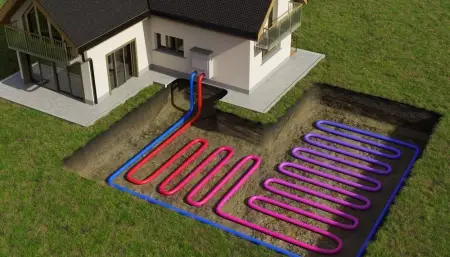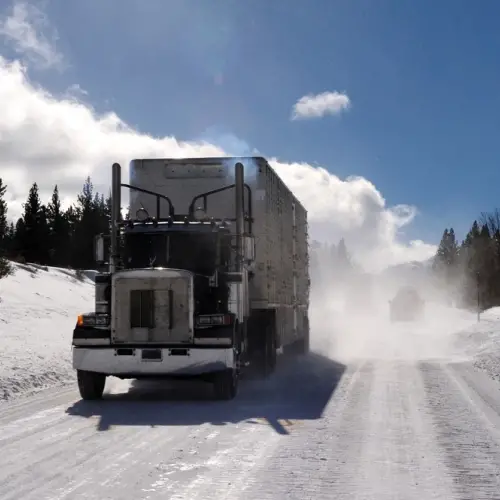
Geothermal energy is a type of renewable energy that is obtained from the heat stored inside the Earth.
It is considered a clean and sustainable source, as it does not require the combustion of fossil fuels and generates low greenhouse gas emissions. This energy can be used directly in the form of heat or converted into electricity using geothermal power plants.
Origin of geothermal energy
 Geothermal energy originates from the Earth's internal heat, which comes from two main sources:
Geothermal energy originates from the Earth's internal heat, which comes from two main sources:
- The decay of radioactive elements : Isotopes such as uranium-238, thorium-232 and potassium-40 decay naturally in the Earth's mantle, generating a constant amount of heat over millions of years. This process contributes significantly to maintaining high temperatures in the interior of the planet.
- Residual heat from Earth's formation : During planetary accretion about 4.5 billion years ago, the collision of celestial bodies and the subsequent compaction of materials released enormous amounts of thermal energy. Although some of this heat has dissipated into space, a large fraction remains trapped in the planet's inner layers, especially in the core and mantle.
The Earth's crust acts as a natural insulator, but in certain regions, called geothermally active zones , heat is more accessible due to the presence of volcanoes, geological faults, geysers or hot springs.
These areas are mainly found at tectonic plate boundaries, where magmatic activity and the circulation of hydrothermal fluids facilitate the transmission of heat from the Earth's interior to the surface.
How is geothermal energy extracted?
Geothermal heat is obtained by drilling wells underground to access the Earth's internal heat.
 Depending on the temperature and depth of the resource, there are different methods of exploitation:
Depending on the temperature and depth of the resource, there are different methods of exploitation:
- Dry steam systems : These are used in fields where steam naturally emerges from underground. The steam is channelled directly to a turbine to generate electricity. Example: The Geysers geothermal power plant in California, USA.
- Hot water or geothermal fluid systems : In this case, hot water or a mixture of steam and water is extracted from underground and passed through a separator that separates the steam from the liquid. The steam drives a turbine and the excess water can be re-injected into the reservoir to maintain the sustainability of the resource.
- Ninary cycle : Used in medium temperature sources, where the extracted water is not hot enough to generate steam directly. A secondary fluid with a lower boiling point is circulated, which turns into steam and drives the turbine.
- Heating and air conditioning systems : For low or very low temperatures, geothermal heat pumps are used, which extract heat from the subsoil to heat buildings in winter and dissipate heat in summer.
Geothermal energy production process
In homes and buildings
One of the main uses of geothermal energy is the air conditioning of buildings and homes. Using geothermal heat pumps, it is possible to extract heat from the ground in winter to heat spaces and dissipate heat from the interior in summer to cool them.
Process in winter:
- The water inside the geothermal collector circuit circulates through the subsoil and is heated.
- A heat exchanger transfers thermal energy to the emitter circuit, which heats the home.
Process in summer:
- Heat from inside the building is transferred to the subsoil, cooling the interior environment.
- Geothermal energy enables an efficient and sustainable cooling system.
In addition, geothermal energy is used in underfloor heating systems and for the generation of hot water.
In geothermal power plants
 Geothermal power plants convert heat from the Earth's interior into electricity through a thermodynamic cycle:
Geothermal power plants convert heat from the Earth's interior into electricity through a thermodynamic cycle:
- Heat Extraction : Geothermal wells are drilled to extract hot water or steam.
- Conversion into mechanical energy : The steam drives a turbine connected to an electric generator.
- Electricity production : Mechanical energy is transformed into electricity, which is injected into the electrical grid.
- Water recirculation : Once used, the cooled water is reinjected into the subsoil to maintain the balance of the aquifer.
Types of geothermal sources
These renewable energy sources are obtained by extracting the Earth's internal heat through geothermal wells. There are several areas with hot springs.
These hot springs can be those used in spas or other centers. These waters are heated by the temperature of the Earth's interior.
Hot water with high internal energy can flow naturally by the impulses of water and steam flows or by pumping. The method to be used must be selected based on the method that is most economically viable.
There is no single method for harnessing this type of energy. There have been projects in some countries that have had to be rejected due to their economic unfeasibility.
Magma (molten rock) is a great source of geothermal energy, as rocks are only found in a liquid state at extremely high temperatures. However, with the technology that is available, it is not economically viable.
Hot water extraction operations usually have an even number of geothermal wells. Hot water is extracted from one well and cooled water is injected back into the aquifer through the other.
Types of geothermal sources
Geothermal energy is classified according to the temperature of the thermal resource, which determines its possible application:
1. High temperature (>150°C)
 This source is found mainly in active volcanic areas, where the magma is relatively close to the Earth's surface. This type of energy allows for the efficient generation of electricity through the use of steam turbines in conventional geothermal power plants. It can reach temperatures of up to 400°C in some deposits, which maximizes the efficiency of the energy conversion process.
This source is found mainly in active volcanic areas, where the magma is relatively close to the Earth's surface. This type of energy allows for the efficient generation of electricity through the use of steam turbines in conventional geothermal power plants. It can reach temperatures of up to 400°C in some deposits, which maximizes the efficiency of the energy conversion process.
A prominent example of its application is the Hellisheiði geothermal power plant in Iceland, one of the largest in the world.
2. Medium temperature (70°C - 150°C)
Medium-temperature sources are located in regions with moderate geothermal activity, where groundwater can be heated to levels suitable for energy production. They are mainly used in binary cycle power plants, which use low-boiling point fluids to generate electricity in turbines.
It is also used in district heating networks, where heat is distributed to multiple buildings through a centralised system. An example of its application is district heating installations in Germany and France, which take advantage of these resources to reduce the use of fossil fuels.
3. Low temperature (50°C - 70°C)
This type is common in more extensive geothermal formations, but with lower thermal intensity. It is mainly used for heating homes, greenhouses and industrial processes such as drying agricultural products and desalination of water.
It can be used in combination with heat pumps to increase energy efficiency in residential and commercial environments.
An example of this use is the use of geothermal energy in greenhouses in the Netherlands to optimize crop growth in cold climates.
4. Very low temperature (<50°C)
Very low temperature geothermal energy is the most accessible form of geothermal energy, as even in non-volcanic areas it is possible to harness the heat from underground. It is used in air conditioning systems using geothermal heat pumps, which allow heat to be extracted in winter and dissipated in summer.
Its energy efficiency is superior to that of traditional heating and cooling systems, making it a sustainable option for homes and commercial buildings.
Examples of its application include geothermal HVAC systems in airports and shopping malls in the US and Canada.
Examples of uses and applications
 Geothermal energy has a wide range of uses:
Geothermal energy has a wide range of uses:
- Building air conditioning : Allows efficient heating in winter and cooling in summer, reducing conventional energy consumption.
- Domestic hot water : Used in homes, hospitals and sports centres, providing a constant and efficient supply of hot water.
- Electricity generation : In geothermal power plants that take advantage of high temperatures to produce electricity in a sustainable manner.
- Industrial processes : It is used in the drying of agricultural products, distillation, pasteurization and sterilization in various industries, optimizing thermal efficiency.
- Spas and thermal tourism : Taking advantage of thermal waters with therapeutic benefits, promoting wellness and health tourism.
- Agriculture and greenhouses : Warming soils and environments to improve agricultural production, allowing crops to be grown in adverse weather conditions and reducing dependence on fossil fuels.
- Water desalination : Using geothermal heat to desalinate seawater, providing a sustainable solution for supplying drinking water in arid regions.
- Road de-icing : Application of geothermal heat to prevent ice build-up on roads and airports, improving road safety in cold climates.